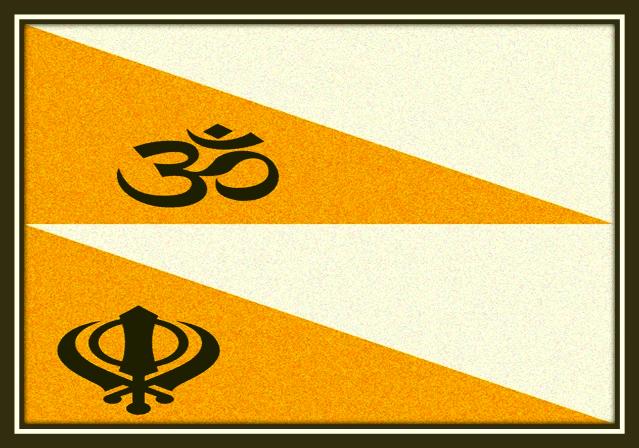Guru granth Sahib, revered as a spiritual master of Sikhs, has openly described the ruthless invasion of Babar and his continuous efforts to raze temples:
Page 417
bābaravāṇī phiri gaī kuiru na roṭī khāi ॥
Since Babar’s rule has been proclaimed, even the princes have no food to eat.
koṭī hū pīra varaji rahāe jā mīru suṇiā dhāiā ॥
Millions of religious leaders failed to halt the invader, when they heard of the Emperor’s invasion.
Page 418
thāna mukāma jale bija maੰdara muchi muchi kuira rulāiā ॥
He burned the rest-houses and the ancient temples; he cut the princes limb from limb, and cast them into the dust.
Along with Hindus, Sikhs have faced atrocities to an unbearable extent during Islamic invasion of India. The killing of Sikh Gurus by Mughals remains a horrifying witness to this fact.
When Hindu and Sikh warriors united to fight and defeat Aurangzeb ’s commander:
Baba Vaishnavdas, a disciple of Guru Samarth Ramdas, created an army of ten thousand chimta-dhari or tong-wielding saints to fight Mughal atrocities. In continuous attempts to reclaim Ram janmbhumi by Hindus and construction of a platform, which had a height equal to a palm, outside Babri mosque structure, Akbar, Jahangir and Shahjahan had allowed prayer offerings by Hindus.
But with Aurangzeb coming into power, he began his atrocities on Hindus and continuously fought to completely reclaiming the holy land. He sent his general Jabaz Khan on a campaign to Ayodhya. Hindus got a hint in advance and, along with the chimta dharis of Baba Vaishnavdas, they defeated the force of Jabaz Khan in a seven day war at Urvashikund.
Foreseeing a counter attack, Baba Vaishnavdas contacted the tenth Guru of Sikhs, Guru Gobind Singh ji, who gladly obliged the request by sending a huge force to Brahmkund. The eighteen year old Guru himself accompanied the army and reached Ayodhya via Prayag.
Miffed with the defeat, Aurangzeb removed Jabaz Khan from the post and deployed a more tyrant general Sayyid Hasan Ali who, along with an army of fifty thousand, attacked Ayodhya.
The united force of Hindus and Sikhs succeeded in defeating Sayyid Hasan Ali, who did not live to face his king. This event is recorded in Alamgir Nama.
In his autobiography Bachitra Natak, Shri Guru Govind Singh Dev has claimed that he was a descendant of Shri Rama’s younger son Lava, and that Guru Nanak Dev was a descendant of Shri Rama’s elder son Kusha (2/18-34, 2/52, 4/1-10 and 5/1-10).
Sikh scholars like Rajendra Singh have extensively debunked the attempts of English scholar McCauliffe who tried to create a divide between Hindus and Sikhs in his book “Sikh Itihas Mein Shri Ram Janmabhoomi“. He explained that the Rama of the Shri Adi Granth is the same Rama that Valmiki introduced as the son of Dasharatha, husband of Sita and King of Ayodhya.
This alone provides an explanation to why Shri Ram’s name is mentioned more than 2500 times in Shri Guru Granth Sahib.
Adding to the unity of two faiths, Guru Gobind Singh ji started a Khalsa panth after the martyrdom of his revered father, Guru Tegh Bahadur – the ninth Guru of Sikhs.
In his famous poem Ugardanti, Guru Gobind Singh ji writes:
‘Sanction me to destroy the evil, end this everyday conflict of Hindus and Muslims.
Ample brave Singh warriors will rise. They will face the Turks and make them defenseless.
Throughout the world, the Khalsa panth will be prominent. The Hindu dharma will prevail, and the Turks (Islamic invaders) will be in flight.’
Sikh shrines in Ayodhya:
Guru Nanak Dev, Guru Tegh Bahadur and Guru Gobind Singh (as a child) visited Ayodhya at different times. There are three Sikh shrines here, all in a cluster, near Brahm Kund on the bank of Saryu. All the three Sikh shrines were taken care of by Brahmin priests and then were handed over to Kashmiri Sikh,Shri Gulab Singh, in the middle of the nineteenth century. He constructed Gurudwara Guru Gobind Singh Ji in 1899 on the site of the platform dedicated to child Gobind Das. An octagonal domed room is named Singhasan Sthan encloses a platform on which are placed the sacred relics – i.e. a pair of sandals believed to be once worn by Guru Tegh Bahadur, a steel arrow, a dagger and a chakra.
Brave Nihang Singh Fakir Khalsa
On 28th November, 1858, Nihang Singh from Punjab entered the structure named Babri mosque and worshipped Shri Ram in the middle of this building. He performed havan and puja and erected a symbol of Shri Bhagwan within its premises. He was accompanied by only twenty five Sikhs who raised religious flags at the mosque and wrote ‘Ram-Ram’ with charcoal all over the walls of the mosque. They created a chabutra or platform near the Mihrab and Mimber and placed the picture of Bhagwan’s idol. This is recorded in a report by Sheetal Dubey, the thanedar of Oudh(Awadh). The miffed Khattib of Babri masjid, Muhammad Asghar, rushed to British government to complaint two days later after the incident, maybe after making sure Nihang Singh is not in the city.
Continuous attempts by Sikhs to reclaim the holy land:
Few years back, in a VHP rally for Ram mandir attended by notable persons like Shri Ashok Singhal, Jagadguru Rambhadracharya, Shiromani Akali Dal openly spoke in favor of building Ram temple and sacrificing their lives for the holy cause.
